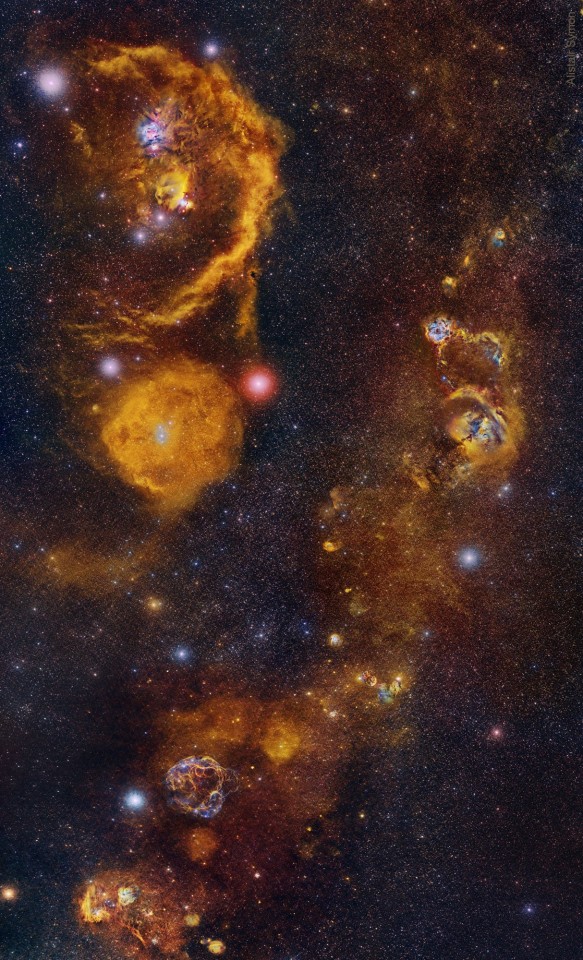Orion Rising Over Death Valley // Brett Nickeson

Orion rising over Death Valley // Brett Nickeson
A few easily-spotted nebulae include Barnard's Loop and the Orion Nebula
More Posts from Chbnb and Others

Further than the last footprint. By - Stanley Chen Xi


Rho Ophiuchi over Mule Ears © astronycc

Earliest Galaxies




NGC6302 Butterfly Nebula

2020 June 30
Bright Planetary Nebula NGC 7027 from Hubble Image Credit: NASA, ESA, Joel Kastner (RIT) et al.; Processing: Alyssa Pagan (STScI)
Explanation: What created this unusual planetary nebula? NGC 7027 is one of the smallest, brightest, and most unusually shaped planetary nebulas known. Given its expansion rate, NGC 7027 first started expanding, as visible from Earth, about 600 years ago. For much of its history, the planetary nebula has been expelling shells, as seen in blue in the featured image. In modern times, though, for reasons unknown, it began ejecting gas and dust (seen in red) in specific directions that created a new pattern that seems to have four corners. These shells and patterns have been mapped in impressive detail by recent images from the Wide Field Camera 3 onboard the Hubble Space Telescope. What lies at the nebula’s center is unknown, with one hypothesis holding it to be a close binary star system where one star sheds gas onto an erratic disk orbiting the other star. NGC 7027, about 3,000 light years away, was first discovered in 1878 and can be seen with a standard backyard telescope toward the constellation of the Swan (Cygnus).
∞ Source: apod.nasa.gov/apod/ap200630.html

A beautiful sunset over Rekvik by Stan

that is amazing

“A splash of wild…“ by | Glenn Lee Robinson

From Auriga to Orion
-
 betani341971 liked this · 2 months ago
betani341971 liked this · 2 months ago -
 getoutandexplore reblogged this · 9 months ago
getoutandexplore reblogged this · 9 months ago -
 huntokar-the-destroyer reblogged this · 10 months ago
huntokar-the-destroyer reblogged this · 10 months ago -
 itznymph liked this · 11 months ago
itznymph liked this · 11 months ago -
 sentient-cereal reblogged this · 1 year ago
sentient-cereal reblogged this · 1 year ago -
 uhumonster liked this · 1 year ago
uhumonster liked this · 1 year ago -
 eseelninokilito liked this · 1 year ago
eseelninokilito liked this · 1 year ago -
 alpacasalways liked this · 1 year ago
alpacasalways liked this · 1 year ago -
 theidiotlibrarian reblogged this · 1 year ago
theidiotlibrarian reblogged this · 1 year ago -
 rhymingwithpurple liked this · 1 year ago
rhymingwithpurple liked this · 1 year ago -
 peppermintschnapps reblogged this · 1 year ago
peppermintschnapps reblogged this · 1 year ago -
 aegol liked this · 1 year ago
aegol liked this · 1 year ago -
 acetrainerjess liked this · 1 year ago
acetrainerjess liked this · 1 year ago -
 nekosigma liked this · 1 year ago
nekosigma liked this · 1 year ago -
 faeryclown reblogged this · 1 year ago
faeryclown reblogged this · 1 year ago -
 chbnb reblogged this · 1 year ago
chbnb reblogged this · 1 year ago -
 chbnb liked this · 1 year ago
chbnb liked this · 1 year ago -
 halosydne reblogged this · 1 year ago
halosydne reblogged this · 1 year ago -
 marple31 liked this · 1 year ago
marple31 liked this · 1 year ago -
 rychazz liked this · 1 year ago
rychazz liked this · 1 year ago -
 verticalceiling reblogged this · 1 year ago
verticalceiling reblogged this · 1 year ago -
 drybonescanharm reblogged this · 1 year ago
drybonescanharm reblogged this · 1 year ago -
 hypermanica liked this · 1 year ago
hypermanica liked this · 1 year ago -
 the-pretty-bird reblogged this · 1 year ago
the-pretty-bird reblogged this · 1 year ago -
 astrangedoor reblogged this · 1 year ago
astrangedoor reblogged this · 1 year ago -
 astrangedoor liked this · 1 year ago
astrangedoor liked this · 1 year ago -
 angelic-salad reblogged this · 1 year ago
angelic-salad reblogged this · 1 year ago -
 angelic-salad liked this · 1 year ago
angelic-salad liked this · 1 year ago -
 ocheeva reblogged this · 1 year ago
ocheeva reblogged this · 1 year ago -
 awesomeatomiccollector liked this · 1 year ago
awesomeatomiccollector liked this · 1 year ago -
 apples4shinigami reblogged this · 1 year ago
apples4shinigami reblogged this · 1 year ago -
 2stepvibe reblogged this · 1 year ago
2stepvibe reblogged this · 1 year ago -
 krzyztopor reblogged this · 1 year ago
krzyztopor reblogged this · 1 year ago -
 krzyztopor liked this · 1 year ago
krzyztopor liked this · 1 year ago -
 littleredhatter liked this · 1 year ago
littleredhatter liked this · 1 year ago -
 rikalna reblogged this · 1 year ago
rikalna reblogged this · 1 year ago -
 dirtymantou reblogged this · 1 year ago
dirtymantou reblogged this · 1 year ago -
 marazhai reblogged this · 1 year ago
marazhai reblogged this · 1 year ago -
 dancingsniper-blog reblogged this · 1 year ago
dancingsniper-blog reblogged this · 1 year ago -
 femmestache reblogged this · 1 year ago
femmestache reblogged this · 1 year ago -
 alforlando liked this · 1 year ago
alforlando liked this · 1 year ago -
 summerwages liked this · 1 year ago
summerwages liked this · 1 year ago
